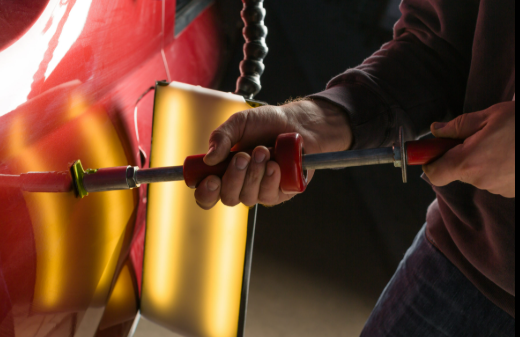Paintless Dent Repair – A Revolution in Auto Body Restoration

Dents and dings are an unavoidable part of owning a vehicle. Whether from hailstorms, door bumps, or low-speed collisions, even minor damage can take away from a car’s pristine look. Enter paintless dent repair (PDR)—a game-changer for those seeking efficient, cost-effective, and non-invasive restoration.
What is Paintless Dent Repair?
Paintless dent repair is a technique that restores the shape of vehicle panels without disturbing the original paintwork. By using a series of metal rods, picks, and other specialized tools, technicians can access the backside of a dent and gently massage the surface back into its original contour.
Unlike conventional body shop methods, which involve grinding, filling, sanding, and repainting, PDR focuses purely on reshaping the metal. No body filler, no paint—just precision and skill.
Why Vehicle Owners Love Paintless Dent Repair
1. Retains Factory Finish
Maintaining the original paint is critical for many reasons—resale value, manufacturer warranty, and appearance. PDR allows for dent removal without compromising the integrity of the factory coating.
2. Saves Time
Traditional repairs can take several days, especially when paint curing is involved. Paintless dent repair, on the other hand, can often be completed within a few hours, depending on the severity and location of the damage.
3. Budget-Friendly
Without the added costs of paint and materials, PDR is usually more affordable than standard bodywork. It’s a financially smart choice for minor to moderate dents.
4. No Color Mismatching
With PDR, there’s no need to worry about blending new paint with the old. The original paint remains untouched, eliminating the chance of mismatched tones.
5. Eco-Conscious Solution
PDR doesn’t rely on chemicals, solvents, or paints, making it one of the most environmentally friendly options for auto body repair.
Ideal Conditions for Paintless Dent Repair
Not all dents qualify for PDR, but many do. It’s typically effective when:
-
The dent hasn’t cracked or chipped the paint
-
The panel is made from metal or aluminum (not plastic)
-
The dent isn’t located on an edge or very tight spot
-
The damage isn’t too deep or creased
PDR is commonly used for hail damage, door dings, shopping cart bumps, and other minor accidents.
Step-by-Step Overview of the PDR Process
-
Assessment – Technicians inspect the damage under lighting to evaluate if PDR is appropriate.
-
Accessing the Area – They remove interior panels or lights to reach the dent’s backside.
-
Tool Work – Using precise pressure, they gently manipulate the metal until the dent disappears.
-
Final Inspection – Lighting systems are used to detect any remaining imperfections.
Choosing Professional Paintless Dent Repair Services
Since PDR requires a high level of skill and finesse, it’s important to hire trained technicians. Look for companies with strong reviews, experience, and proper certification. A professional can ensure a clean result without causing additional damage.
Conclusion
Paintless dent repair has quickly become the preferred method for handling small to mid-sized vehicle dents. It’s fast, affordable, and doesn’t compromise the vehicle’s original paint. For anyone seeking a smart alternative to conventional auto body repairs, PDR is the modern solution that checks all the boxes.
- Art
- Causes
- Crafts
- Dance
- Drinks
- Film
- Fitness
- Food
- Games
- Gardening
- Health
- Home
- Literature
- Music
- Networking
- Other
- Party
- Religion
- Shopping
- Sports
- Theater
- Wellness


